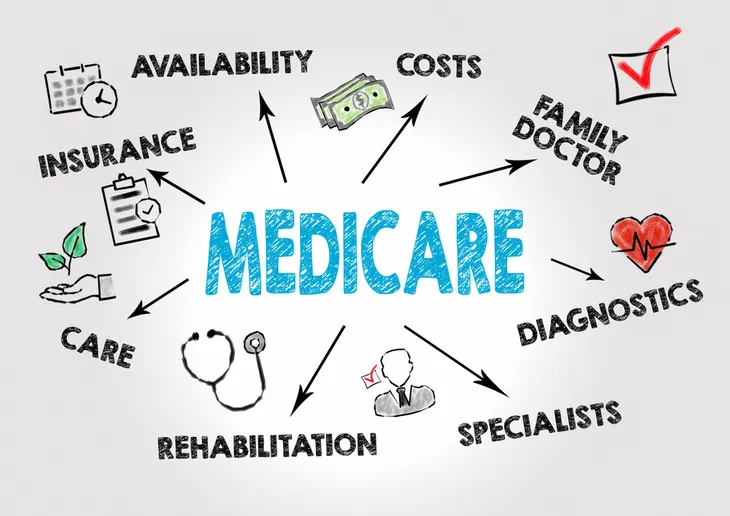Changes are coming to Medicare in 2021. Are you prepared? While this isn’t anything new, it is important to be aware of what changes are to come to ensure you have enrolled in the best plan for you and to prevent any surprises.
In 2021 we can expect to see several premium increases, coverage changes, and more. If you’re worried about missing out on all the important modifications, don’t fret! We’re here to help. Follow along with our detailed list of all the 2021 Medicare changes every American must know!
Want senior content delivered straight to your inbox? Sign up for our exclusive email list and receive articles and news on diet & nutrition, fitness, and mental health dedicated specifically to our senior audience!
Part A Premiums Are Increasing
About 1-percent of people enrolled in Medicare Part A pay premiums while the others get it for free based on their (or their spouse’s) work history. Previous years have shown that Part A premiums are increasing and we should expect it for 2021.
People with over 30 quarters of work history, but less than 40 can expect their Part A premium to increase to $263 per month which is up from $252 per month in 2020. The projection for those with less than 30 quarters of work history is $478 per month in 2021 which is up from $458 per month in 2020. The finalized increase will be determined by the Centers for Medicare & Medicaid Services (CMS) later this year.
Medicare Part A Deductibles Are Increasing
Are you wondering if the Medicare Part A deductible will be increasing for 2021? The answer is, most likely. This is because each year the deductible has increased. In 2019 it was $1,364 and then it increased to $1,408 in 2020. With this in mind, the deductible is projected to increase to $1,452 in 2021.
Again, keep in mind the finalized increase will be determined by CMS later this year. The deductible does apply to all enrollees but many of you may have supplemental coverage that will pay part or all of the Part A deductible.
Changes to Medicare Part B Premiums
Just like the premium increases for Medicare Part A, we can expect to see an increase in the premiums for Part B. In 2020, the premiums for Part B were $144.60 per month and they are projected to increase to $153.30 per month which is about a 6-percent increase.
Thankfully, there is a proposed bill that will cap the increase at 25-percent of what it is projected to be in 2021. This means, if the bill passes, the premium for Part B won’t increase more than $2. The final premium increase for 2021 will be released later this year.
Can You Still Buy Medigap Plans C and F?
In 2020 we saw one of the biggest changes in Medicare. It was announced that people who are newly eligible for Medicare will no longer be able to purchase Medigap Plan C and F starting January 1, 2020. If you’re eligible for Medicare this year and are wondering if you can still buy Medigap Plans C and F, the answer is, no. However, if you were eligible for Medicare prior to 2020 you can keep Plan C and F if you already have it, or you can apply for it at a later date.
The reason it changed was to discourage overutilization of services so that enrollees have to pay at least something when they received outpatient care. Since the Plan F has been discontinued, a new high-deductible plan, Plan G has been made available instead.
Changes for Medicare Beneficiaries in High-Income Brackets
If you’re a Medicare beneficiary and you have a high income, you should expect to pay more for Part B and Part D. The high-income brackets were introduced for Plan B in 2007 and Plan D in 2011. You were considered in the high-income bracket when you earned $85,000 a year or more, or $170,000 as a married couple. However, the income brackets started adjusting for inflation last year and increased to $87,000 per year and $174,000 for a married couple.
It’s projected that we’ll see another change in 2021 to $88,000 for a single person and $176,000 for a married couple. You should also know that the Part B premium is projected to increase in 2021 too. High-income beneficiaries should anticipate paying a premium of about $215 to $521 per month (depending on income) which is an increase from the 2020s $202.40 to $491.60 per month premiums.
Changes to Medicare Advantage Premiums
Not all premiums are increasing. The average Medicare Advantage (Medicare Part C) premiums are projected to decrease to $21 per month in 2021 which is down from $23 per month in 2020. The Average Advantage premiums have been slowly declining for a few years and next year will be the lowest it’s been since 2007. However, keep in mind that Medicare Advantage plans that include Part D prescription drug coverage (MA-PDs), the average premium is about $36 per month.
It’s also important to note you should expect Medicare Advantage premiums in addition to Part B premiums. Meaning you’ll have to pay a premium for your Medicare Advantage plan as well as the Part B premium.
Changes to Medicare Advantage Out-Of-Pocket Maximum
Caps on out-of-pocket costs are required for Medicare Advantage plans for Part A and B. Although, keep in mind, the cap does not include the costs of prescription drugs as those are covered under Medicare Part D.
The cap has been $6,700 for the last several years (with the exception of some plans that are below that level). In 2021, it’s projected that the maximum out-of-pocket cap for Medicare Advantage plans will significantly increase to $7,550. Don’t forget, this increase does not include the out-of-pocket costs for prescription drugs.
Changes to Medicare Advantage Coverage
In addition to changes in the Advantage plans premiums and out-of-pocket maximum, we will see some changes in the coverage as well. It’s projected that in 2021, the Advantage plans will be increasing their telehealth services and coverages. Further, enrollees who live in rural areas may also see an increase in available policy options.
CMS will give Advantage plans the flexibility to include telehealth providers in several areas such as gynecology, cardiology, dermatology, psychiatry, primary care, and endocrinology. CMS Administrator Seema Verma said, “CMS’s rapid changes to telehealth are a godsend to patients and providers and allows people to be treated in the safety of their home,”
Furthermore, these coverage increases will give beneficiaries who have end-stage kidney disease (ESRD) more options. The implemented changes are made by the 21st Century Cures Act which will give ESRD beneficiaries the option to enroll in a plan starting in 2021.
Changes to Medicare Part D Prescription Drug Coverage
For standard Part D plans, the maximum allowable deductible is projected to increase to $445 in 2021 which is up from $435 in 2020. But that isn’t the only change we’ll see. The out-of-pocket threshold which is where the catastrophic coverage begins is projected to increase to $6,550 in 2021. This is a significant increase from 2020 which is currently set at $6,350.
Keep in mind, once the catastrophic coverage begins you still have to pay out of pocket. Even the copay amounts are set to increase slightly to $3.70 for generics and $9.20 for brand-name drugs.
Thankfully, the Affordable Care Act closed the donut hole in 2020 for Medicare Part D. This means that people enrolled in the standard Part D plans pay 25-percent of the cost after they meet their deductible and until they reach the catastrophic coverage threshold. This is a much better option than prior to 2010 when you had to pay 25-percent of the cost until you reached the donut hole and then you would have to pay 100-percent of the cost until you reached the catastrophic coverage threshold.












